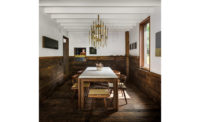Sebastian Mariscal found his professors not in the halls of academe, but in the offices of practicing architects. Starting when he was 14, he spent afternoons and evenings after school working for his father, Raul Octavio Mariscal, a public-housing architect in Mexico City. "It was a very intense education," Mariscal says, "and it influenced my perspective that architecture has a social responsibility." Eschewing a formal architectural education, four years into his apprenticeship with his father, he opened his own design firm. He remodeled some interiors, then designed buildings in Mexico ranging from houses to a television studio.
He closed his Mexico City firm in 1995 to work for architect Tonet Sunyer in Barcelona, then moved to San Diego to join Jonathan Segal, FAIA, and learn about Segal's business combining architecture and real estate development. In 2000, Mariscal went out on his own again with State+Date, a two-family residence he built with an investor partner. By designing and managing the project efficiently—confining all plumbing to one wall, for example, and ordering all precut parts—he minimized on-site labor. And by deftly organizing his construction crew, he finished the building in four months. Today, his firm handles architectural commissions and his own development projects; another arm of the business does general contracting.
While Mariscal owes an obvious debt to Segal, he also borrows from his two other mentors. Calling his previous employment stints "ingredients" in his technique, Mariscal notes, "The more we can add to our design process, the less subjective architecture can be and the more transcendental the building can become for the user and the city." Like his father, Mariscal focuses on residential buildings, mostly located on challenging urban sites. "I don't believe in suburbia," he says. "I believe in eliminating the use of cars and increasing the intensity of the city experience." The lower market value of difficult sites "also cuts my purchase price, while posing the challenge of making a good piece of architecture."
Mariscal designed the two-family building On Grape on just such a site, devising a pair of units each measuring 36-by-68 feet. To buffer occupants from the busy street corner, he developed a ventilated facade made of engineered stone and Cor-Ten steel clipped to the building's wood framing, creating a heat- and noise-protecting pocket of air. Then he connected the units' front and rear volumes with bridges traversing an internal, bamboo-filled courtyard. In addition to offering a glimpse of nature in downtown San Diego, the plan obliges residents to end their day with a pleasant ritual: crossing the bridge and retiring to the bedroom.
On Grape also underscores Mariscal's interest in merging indoors and out, which he picked up from Sunyer and finds well suited to the temperate climate of both Mediterranean Spain and Southern California. At 2inns, Mariscal surrounded the main living area with a perimeter of glass doors that can fold away, exposing guests to the elements and views of the Pacific Ocean. And for the Tercio Winery in Mexico's Baja peninsula, he created just a shell that remains open on one side. Moving back and forth between the U.S. and Mexico, between designing and building, Mariscal remains open, too'to ideas from different places and disciplines.











